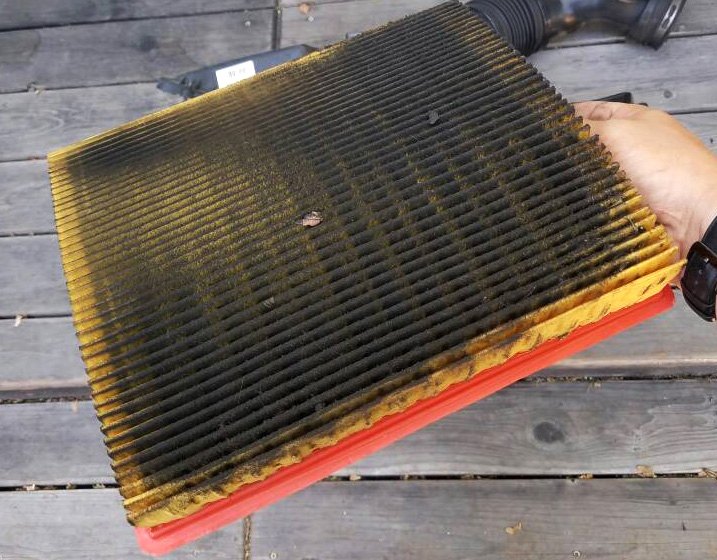You likely know that today's automobile engines run on an air/fuel mixture that is precisely metered for optimum combustion, power, and fuel efficiency. But did you know that a dirty engine air filter can throw that ideal ratio off? An air filter overdue for replacement can trigger a check engine light if numerous running conditions should get out of whack as a result.
A poorly-running engine may be a worse-case scenario, but the problem occurs across the land because of dirty and clogged air filters. This is because airflow into the intake manifold doesn't just get restricted, it becomes uneven and unpredictable. In other words, it becomes a big problem for engine control modules, throttle bodies, and catalytic converters to manage.

In this article, we'll discuss why and how often air filters should be replaced, how they affect performance, and why you shouldn't necessarily rely on your vehicle manufacturer's recommended replacement schedule.
How Have Car Makers' Replacement Intervals Changed?
Traditional wisdom has always stated that engine air filters should be replaced every 15,000 to 20,000 miles - especially if you drive on unpaved roads or smoggy areas where contaminants are a bigger factor. But taking a look at the factory maintenance schedule on some of today's best-selling vehicles, we note that the new recommended norm for air filter replacement seems to have increased to 30,000 miles. On the extreme end of the spectrum, late-model Chevy Silverado guidelines say to replace it every 45,000 miles, and the BMW 3-Series calls for 50,000-mile replacement intervals.
It seems to have become a trend for automakers to change their tune on air filter replacement. Many of them used to actually recommend new filters every 15,000 or 20,000 miles. It's possible they've honestly come to believe, through trial and error, that this maintenance item is not needed as often. But when you consider that the level of dust, pollution, and other contaminants in the air has not magically dropped in half recently, such reasoning seems hollow.
We suspect the stretch might be because a number of automakers now provide free maintenance plans for the first 2 to 3 services, over a period of 2 to 3 years. Stretching engine air filter replacements to 30,000 or more miles puts it outside of the covered period, so the customer pays for it instead. And if there's no free maintenance plan to speak of, stretching air filter replacement yields lower cost of ownership numbers. This makes for effective advertising claims to entice buyers watching every penny, especially as 8-year car loans are becoming more common.
Why Are Clean Air Filters Important?
Any internal combustion engine, whether it's gasoline, flex-fuel ethanol, diesel, or even biodiesel, requires clean air to mix with fuel to do its job. More specifically, it's been estimated that for every gallon of fuel burned, up to 10,000 gallons of air are required to produce the ideal air/fuel mixture of 14.7 parts air to 1 part fuel.
Without a proper air filter, dust, dirt, or other debris would get into the engine and quickly cause significant abrasive wear on pistons, piston rings, cylinder walls, valves, camshafts, connecting rods, and related bearings.

Traditional air filters sit within a sealed housing (usually a plastic container with a lid) under the hood of modern vehicles. The pleated paper mesh within the filter traps dust and particles of all sizes - holding them within the filter so they never reach the engine.

Naturally, the effectiveness of air filters decreases as they become loaded up with dirt. Larger bits of debris can even end up collecting in the bottom of the airbox. A filter that becomes excessively clogged creates a struggle for the engine to breathe. Because reduced airflow through the filter creates a higher vacuum draw, some of the larger debris particles in the box (or the filter) may even be sucked out past the filter and into the engine. So a really dirty air filter can actually create a problem that it was intended to solve.

You paid good money for the power and/or fuel economy your vehicle was built with. A dirty air filter will cost you on both of those fronts.
Depending on your vehicle's level of electronic sophistication with fuel management, gas mileage may or may not suffer to a huge extent - but it will be reduced. A dirty air filter will also cause a noticeable lack of power under heavy acceleration, at high speeds, and during hill climbing simply because too little air is getting through.
A recent U.S. Energy Department study found dirty air filters can hurt acceleration by 6 to 11 percent. Additionally, when on board computers sense that the air/fuel mixture is too rich, fuel delivery will automatically be cut back in order to return the mixture to proper levels. In a further attempt to right things, spark timing may also be revised. Naturally, this creates a deeper power drop.
Knowing When It's Time To Change The Filter

Because loss of power and mileage occur gradually as an air filter gets dirtier, those are not reliable indicators when it comes to gauging the condition of your air filter. The best way to monitor its condition is simply to pull it out and have a look. That way, you can also be sure no small animals have stashed acorns or nesting material in the air filter box. It happens. And you can inspect the box itself to make sure it doesn't have any cracks in it. For these reasons, we recommend having a look after one year or 15,000 miles, whichever comes first. The good news is, they're easy to check. The further good news is, they're quite affordable and easy for the DIYer to replace.
A rule of thumb says if your air filter is a pleated paper one, hold it front of a flashlight or bright light bulb to see how much light makes it through. If the amount of light coming out is about 50% or more, the filter has enough life left to continue using it. With a filter made of dense fabric, however, this test does not apply.


As we've mentioned, an engine that's continuously starved of air will suffer from a condition where the air/fuel mixture is too fuel-heavy. That excess unburned fuel will gradually leave carbon deposits on the spark plugs. As they begin to foul, you may notice hesitation and excess exhaust smoke under cold start or heavy acceleration conditions.
If spark plug misfires are detected by the vehicle's engine computer frequently enough, the check engine light will come on. Unburned fuel going out the exhaust system always shortens the lifespan of any catalytic converters attached to it as well - and these are very expensive components to replace.

When you consider how effortless it is to check and replace an air filter, there's no reason to allow a dirty one to clog your engine's airflow, dampen your vehicle's performance, and cost you money for related repairs.
Opportune Times To Replace Your Air Filter
As we mentioned above, on the majority of cars, the air filter is readily accessible. A good rule of thumb is to combine it with another routing service item that's done on a time/mileage basis, such as an oil change. Remind yourself by purchasing both the oil AND the air filters at the same time. While the hood is open and you're refiling the crankcase, pop the air filter box clips, and you'll have the new filter in place before the final quart has made its way to the bottom of the engine.
If you're performing this task strictly based on the calendar, we find that the annual spring or fall checkover serves as a great reminder. In the spring, as you're removing snow tires and checking the health of the A/C, eyeball the air filter. Or, in the fall, when you're replacing wiper blades and testing the heating system, add "air filter" to the to-do list.
If you're not sure which engine air filter or housings would match your car or truck, just enter its year, make, and model details in our "Select Vehicle" box along the top of the screen. Our system will then present only those items which are an exact, vehicle-specific fit. And don't hesitate to check out our higher-performing air filters before you make your purchase. We also welcome any further product inquiries you may have - just give us a call seven days a week!

